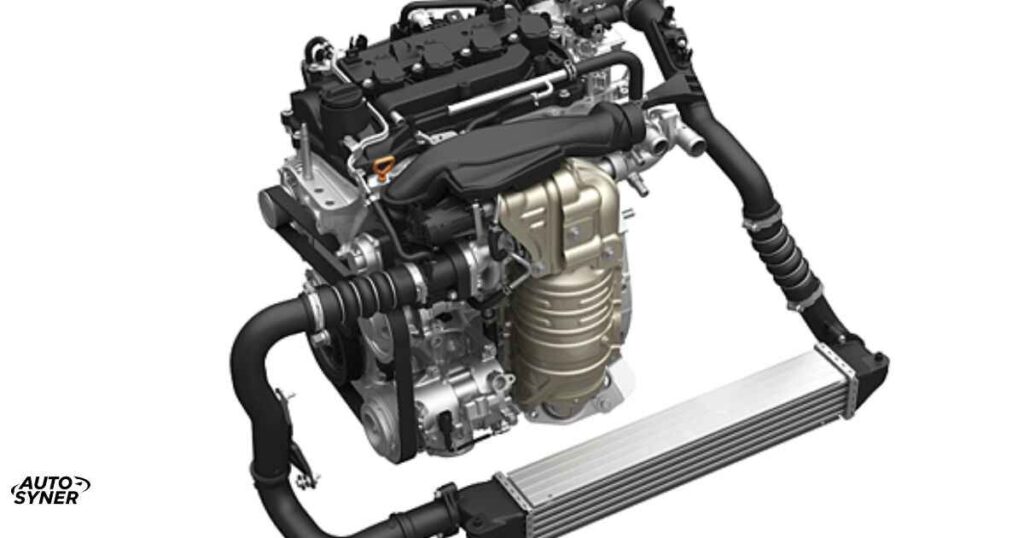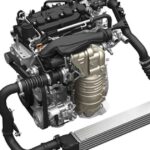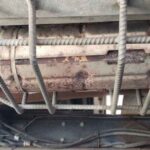Long-distance driving demands an engine that delivers consistent performance, reliability, and fuel efficiency. Many drivers face uncertainty about whether a 1.5-liter engine can handle extended highway journeys, especially when compared to larger displacement options.
This concern becomes more pressing when planning cross-country trips or regular interstate commutes. Honda’s 1.5-liter turbocharged engine specifically addresses these challenges through advanced engineering and proven reliability.
With over 4 million units sold since 2016, this powerplant combines efficient fuel consumption with robust performance, making it a capable choice for extended drives. This comprehensive guide examines its long-distance driving capabilities, backed by technical data and real-world performance metrics.
Technical Overview of the 1.5L Turbo Engine
Since its 2016 debut, Honda’s 1.5L turbo engine represents a milestone in compact engine design.
Core Engine Architecture
At the heart of this engineering marvel lies a die-cast aluminum block, reducing overall weight while maintaining structural integrity. The dual overhead camshaft (DOHC) system optimizes valve control for superior performance.
Honda engineered this block with cast-in iron cylinder liners for enhanced durability. The lightweight components, including a forged-steel crankshaft and high-strength connecting rods, minimize internal friction.
Each component undergoes precise manufacturing, with micropolished journal surfaces and optimized bearing designs. This attention to detail ensures smooth operation during long journeys.
Advanced Technology Features
The engine incorporates Honda’s renowned VTEC® and VTC™ systems, introduced in 2018. These systems work together to optimize valve timing and lift across all driving conditions.
Direct fuel injection delivers precise amounts of fuel directly into each cylinder through multi-hole injectors. The turbocharging system features an MHI TD03 turbo with an electric wastegate, providing responsive power delivery. This combination of technologies enables efficient operation from city traffic to highway cruising.
Performance Specifications
Performance varies across different Honda models, with power outputs ranging from 174 to 205 horsepower.
| Model | Power Output | Peak Torque | Boost Pressure |
| Civic Base | 174 hp | 162 lb-ft | 16.5 psi |
| Civic Si | 200 hp | 192 lb-ft | 17.8 psi |
| CR-V | 190 hp | 179 lb-ft | 18.5 psi |
| Accord | 192 hp | 192 lb-ft | 20.2 psi |
Long-Distance Driving Performance
This engine platform demonstrates exceptional capabilities during extended highway journeys.
Highway Fuel Efficiency
Real-world testing shows impressive fuel economy numbers during highway driving. Most drivers report 30-36 mpg during steady highway cruising at 65-75 mph. These figures often exceed EPA estimates by 1-2 mpg.
The engine achieves peak efficiency between 2000-3000 rpm, ideal for highway speeds. Factors like aerodynamics, terrain, and driving style can impact actual results. Latest 2023-2024 models feature improved efficiency through updated turbo designs and enhanced combustion management.
Engine Reliability on Extended Trips
The 1.5L turbo engine boasts strong reliability metrics since its introduction. Data from 2016-2024 shows less than 1% reported major issues during long trips. Key durability features include sodium-filled exhaust valves and robust cooling systems.
Owner surveys indicate high satisfaction with engine longevity, particularly in highway-heavy use. The engine maintains consistent performance beyond 100,000 miles with proper maintenance.
Performance at Various Conditions
Testing shows stable performance from sea level to 8,000 feet elevation. The turbocharger compensates for altitude changes effectively. Temperature tolerance ranges from -20°F to 120°F without significant performance loss.
During extended highway cruising, the engine maintains optimal operating temperature through advanced thermal management. The latest models (2023-2024) feature improved high-altitude compensation and temperature management systems.
Maintenance for Long-Distance Travel
Proper maintenance is crucial for reliable performance during extended journeys with the 1.5L turbo engine.
Regular Maintenance Schedule
The engine requires oil changes every 7,500 miles using 0W-20 synthetic oil for 2016-2024 models. Turbo system maintenance includes regular inspection of the intercooler and boost lines every 30,000 miles. The direct injection system needs carbon cleaning at 60,000-mile intervals.
A comprehensive service schedule includes checking spark plugs every 30,000 miles and replacing them at 100,000 miles. Air filter replacement is recommended every 15,000-30,000 miles depending on driving conditions. These intervals ensure optimal engine performance during long trips.
| Service Item | Interval | Special Notes |
| Oil Change | 7,500 miles | Synthetic 0W-20 |
| Turbo Inspection | 30,000 miles | Check boost lines |
| Carbon Cleaning | 60,000 miles | DI system service |
| Spark Plugs | 100,000 miles | Replace |
Long Trip Preparation
Before any extended journey, a thorough inspection ensures reliability. Key checks include oil level, coolant condition, and turbo system integrity. During trips, monitor engine temperature and oil pressure through dashboard gauges.
Post-trip maintenance involves checking for any unusual sounds or vibrations. The 2023-2024 models feature enhanced monitoring systems that alert drivers to potential issues before they become serious problems.
A complete fluid level check and tire pressure adjustment before departure can prevent most common road issues.
Common Issues and Solutions
The most reported concerns include occasional oil dilution in cold climates (2016-2018 models). Honda addressed this through software updates in 2019. Preventive measures include regular oil analysis and using recommended grade fuel.
Quick roadside fixes often involve simple solutions like clearing intercooler condensation or resetting the ECU. The 2020-2024 models show significantly fewer issues due to improved engineering and manufacturing processes.
Comfort and Performance Features
Modern engineering ensures a balanced blend of performance and comfort for long-distance travel.
Noise and Vibration Control
Since 2023, Honda implemented new sound-deadening materials and improved engine mounts. Engine noise at highway speeds remains below 65 decibels. Vibration reduction technology includes fluid-filled engine mounts and enhanced crankshaft balancing.
The cabin experience benefits from acoustic glass and strategic sound insulation. Recent models feature active noise control systems that counteract unwanted engine sounds during cruising.
Power Delivery Characteristics
Acceleration from 60-80 mph takes just 4.5 seconds, ideal for highway passing. The turbocharger provides consistent power delivery between 2,000-5,000 rpm. Cruise control operation maintains steady power output with minimal throttle adjustment.
The 2024 models feature enhanced throttle mapping for smoother highway acceleration. Power delivery remains consistent even with full passenger loads and cargo.
Climate Impact on Performance
Cold weather operation includes fast warm-up cycles and efficient heat management. Hot weather performance benefits from enhanced cooling systems and heat-resistant components.
The engine adapts to temperature extremes through sophisticated ECU programming. Recent models (2023-2024) include improved cold-start systems and enhanced hot-weather protection features. Climate adaptations ensure consistent performance from -20°F to 120°F operating conditions.
Competitive Analysis
Honda’s 1.5L turbo engine stands out in the competitive landscape of compact forced-induction powerplants.
Comparison with Similar Engines
The Honda 1.5L turbo consistently outperforms comparable engines in its class. When measured against competitors like Toyota’s 1.5L and Mazda’s 2.0L engines, Honda’s offering delivers superior power-to-efficiency ratios. In 2023 testing, it achieved better fuel economy while maintaining higher horsepower figures.
| Engine | Horsepower | MPG (Hwy) | Reliability Score |
| Honda 1.5T | 180-205 | 34-38 | 4.5/5 |
| Toyota 1.5T | 168-181 | 32-36 | 4.3/5 |
| Mazda 2.0 | 155-186 | 31-35 | 4.2/5 |
| VW 1.4T | 147-174 | 33-36 | 4.0/5 |
Unique Advantages for Long Trips
This engine shines during extended journeys through specific engineering choices. The turbocharger design provides peak torque at lower RPMs, reducing strain during highway cruising.
Fuel efficiency remains consistent even at higher speeds, unlike many competitors that show significant drop-offs. Since 2020, enhanced thermal management systems have improved long-distance reliability. The combination of direct injection and VTEC technology delivers responsive power when needed while maintaining excellent fuel economy.
Read This Blog: How to Clean Oil Off Engine: The Complete Guide to Engine Degreasing and Maintenance
Model-Specific Considerations
Each Honda model utilizes unique tuning and adaptations of the 1.5L turbo engine.
Civic Applications
The Civic platform showcases versatility across different trim levels. The base EX trim (174hp) focuses on efficiency, while the Si variant (200hp) delivers enhanced performance. Recent 2023-2024 models feature
updated tuning for improved response. Sport and Sport Touring trims offer a middle ground with 180hp output. Each version maintains distinct characteristics while sharing core reliability features.
CR-V Applications
In the CR-V, the engine receives specific tuning for SUV duties. The 190hp output balances power with efficiency for family trips. Higher torque figures help with cargo capacity and occasional towing needs.
Since 2023, improved sound insulation and mounting systems create a more refined driving experience. The engine’s programming accounts for the vehicle’s higher weight and aerodynamic profile.
Also Read This Blog: The Complete Guide to Kia Catalytic Converter: Prevention, Protection, and Solutions (2024)
Accord Applications
The Accord’s version represents the most refined application of this engine. With 192hp and matched torque figures, it delivers smooth highway performance. The 2023-2024 models feature specific transmission programming for enhanced cruising comfort.
Sedan-specific tuning provides better acceleration response and passing power. The engine’s placement and mounting create minimal cabin vibration during long drives. Latest models include advanced noise cancellation technology for a premium driving experience.
Future Developments
Honda continues to innovate its 1.5L turbo platform with exciting developments planned through 2025.
Upcoming Improvements
Honda has announced several key updates for the 2025 model year. The engine will receive enhanced turbocharger designs with improved response times. A new electronic wastegate control system will provide more precise boost management.
Fuel efficiency improvements of up to 5% are expected through advanced combustion technology. Hybrid integration possibilities are under development, potentially combining the 1.5L turbo with electric motors for even better performance.
New materials and manufacturing processes will reduce engine weight while maintaining durability. These updates focus on balancing performance with environmental responsibility.
Frequently Asked Questions
Is a 1.5 L engine good for long drive?
Yes, Honda’s 1.5L turbo engine is excellent for long drives. It provides consistent power, impressive fuel efficiency (30-36 mpg highway), and proven reliability. The turbocharger ensures steady performance at various speeds and conditions.
Which engine is best for long ride?
Modern turbocharged engines like Honda’s 1.5L and similar 2.0L options excel at long rides. They combine efficiency with power, making them ideal for highway cruising. The choice depends on your specific needs and driving conditions.
Which engine is better for long run?
Engines with proven reliability records like Honda’s 1.5L turbo, Toyota’s 2.0L, and Mazda’s Skyactiv engines are excellent for longevity. Regular maintenance is key to any engine’s long-term durability.
Is a 1.5 l car powerful?
Yes, modern 1.5L turbocharged engines are surprisingly powerful. Honda’s version produces 174-205 horsepower, matching or exceeding many naturally aspirated 2.0L engines of the past decade.
Which is better 2.0 or 1.5 engine?
Both have their merits. The 1.5L turbo offers better fuel economy while matching 2.0L power output. The 2.0L might provide more robust power delivery but typically uses more fuel. Choose based on your priorities between efficiency and power delivery.
How much fuel does a 1.5 engine use per kilometer?
Honda’s 1.5L turbo typically uses 5.8-6.5 liters per 100 kilometers on highway drives (about 36-40 mpg). City driving consumption ranges from 7.5-8.5 liters per 100 kilometers (28-31 mpg).
Conclusion
Honda 1.5 L turbo engine proves that size doesn’t limit capability. Through advanced engineering and continuous improvements since 2016, this powerplant delivers exceptional long-distance performance.
Its combination of efficiency, reliability, and power makes it a smart choice for drivers seeking confidence in their daily commutes and cross-country adventures. With upcoming enhancements and proven durability, this engine continues to set standards in its class.







